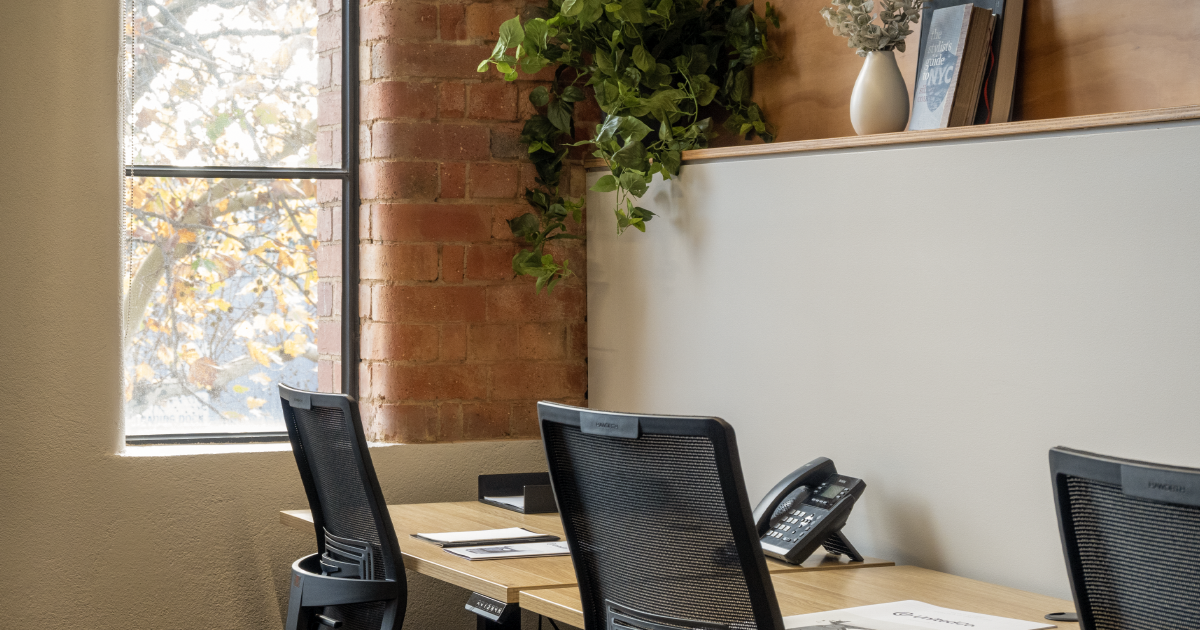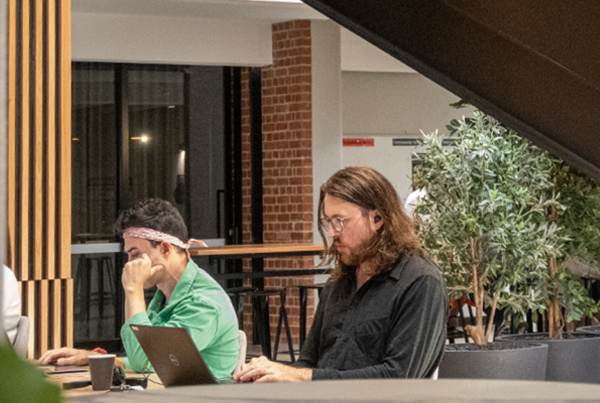
When it comes to office space per person, how much office space is required?
Determining the exact amount of office space per person can vary depending on several factors. However, there are industry standards and general guidelines that can help estimate the office space needed. It’s important to note that these figures can vary based on the specific requirements and work culture of an organization. Here are some common benchmarks when it comes to asking how much office space is required:
Traditional Approach
Around 100 to 250 square feet per person
This approach typically applies to organizations with more traditional office layouts, including private offices or cubicles.
Open Plan Offices
Approximately 75 to 150 square feet per person
Open plan layouts utilize shared workstations or benches without dividing walls, offering a more collaborative and flexible environment.
Agile/Flexible Workspaces
Roughly 50 to 100 square feet per person
Agile workspaces often incorporate hot desking, shared workstations, and collaboration areas. As employees do not have assigned seats, less space is allocated per person.
Activity-Based Working
Typically 50 to 100 square feet per person
Activity-based working focuses on providing different work settings for various tasks, such as individual workstations, meeting rooms, quiet zones, and collaboration spaces.
High-Density Workspaces
As low as 35 to 50 square feet per person
Some organizations may adopt high-density workspaces to optimize space utilization. This often involves compact workstations or benching systems.
Remember that these figures serve as general guidelines, and it’s crucial to consider the specific needs and work requirements of your organization. Factors such as job function, equipment, storage requirements per employee amount, and collaboration needs can influence the ideal amount of an office space you need, per person. Conducting a thorough space analysis, considering employee feedback, and consulting with professionals experienced in office design can help determine the most suitable office space allocation for your organization.
Factors Influencing Office Space Requirements for the average office space
Several factors can influence the office space requirements for an organization. Understanding these factors is essential for effective office space utilization. Here are some key factors that can influence office space size and requirments.
Job Functions and Roles
The nature of different job functions and roles within an organization can greatly impact the space required. For example:
Administrative staff may require more space for smaller workstations with enough space for limited storage needs.
Creative teams or departments may have office space you need larger work areas for brainstorming and collaboration.
Managers or executives may require private offices or dedicated meeting spaces.
Collaboration and Communication Needs
The level of collaboration and communication required among employees can affect the office size and space requirements, when it comes to how much office space per employee is needed.
Consider:
- Teams that collaborate frequently may need shared spaces or open plan layouts to encourage interaction.
- Departments that require privacy for confidential discussions or sensitive information may need separate meeting rooms or enclosed offices.
Technology and Equipment
The type and quantity of technology and equipment used by employees can impact the space needed. Consider:
Employees who rely heavily on technology, such as software developers or graphic designers, may require additional space for specialized equipment.
Storage requirements for physical files, equipment, or inventory also influence space needs.
Future Growth and Scalability
Organizations should consider their growth plans and scalability when determining office space requirements. Factors to consider include:
Anticipated employee growth over a specific period and the ability to accommodate future needs for additional staff.
Flexibility to reconfigure or expand office spaces in the future without major disruptions.
Work Culture and Environment
The work culture and desired environment play a significant role in office space requirements. Consider:
Organizations focused on collaboration and open communication may opt for open plan layouts or shared workspaces.
Companies that value privacy or deal with sensitive information may prioritize private offices or enclosed meeting rooms.
Regulatory and Compliance Requirements
Certain industries or organizations may have specific regulatory or compliance requirements that impact office space needs. Examples include:
Healthcare facilities requiring specific room layouts, privacy considerations, or medical equipment. Financial institutions needing secure areas for confidential discussions or data storage.
Amenities and Support Spaces
Consider the need for common areas, break rooms, conference rooms, and support spaces when determining office space requirements. These spaces enhance employee well-being, productivity, and convenience.
It’s important to conduct a thorough analysis of these factors, considering the unique needs of your organization, to arrive at an accurate assessment of office space requirements. Regularly reviewing and adapting to changing requirements will help ensure optimal office space utilization.
The Role of Ergonomics in Office Space Planning
Ergonomics plays a crucial role in office space planning as it focuses on creating work environments that promote the health, safety, and productivity of employees. When designing office spaces, considering ergonomic principles can have significant benefits for both individuals and organizations.
One of the key aspects of ergonomics in planning is the design of workstations. An ergonomic approach ensures that workstations are designed to optimize comfort and efficiency. This involves considering many factors, such as desk height, layout, and equipment placement. For example, having adjustable desks and chairs allows employees to customize their workstations to their individual needs, promoting good posture and reducing the risk of musculoskeletal disorders.
Incorporating ergonomic principles into planning also involves considering the placement of equipment such as monitors, keyboards, and mice. Positioning these items correctly can help reduce strain on the neck, shoulders, and wrists. Ergonomic keyboards and mice with features like wrist rests and proper alignment can also contribute to improved comfort and reduced repetitive strain injuries.
In addition to individual workstations, ergonomics considers the layout and design of common areas, such as meeting rooms and break areas. By ensuring that these spaces are ergonomically designed, organizations can create environments that promote collaboration, comfort, and well-being. For example, providing comfortable seating, adequate lighting, and proper acoustics in meeting rooms can enhance the overall experience and productivity of employees during collaborative sessions.
Overall, the role of ergonomics in office space planning is to create work environments that prioritize the physical well-being and comfort of employees. By considering ergonomic principles when it comes to how much office space companies may need, organizations can reduce the risk of work-related injuries and musculoskeletal disorders, improve employee satisfaction and productivity, and ultimately create a healthier and more efficient workplace.
Agile Workspaces: Adapting to Modern Workstyles
Agile workspaces have gained popularity in recent years as organizations adapt to modern workstyles and the evolving needs of their employees. These workspaces are designed to foster flexibility, collaboration, and productivity. Here’s a closer look at agile workspaces and their role in accommodating modern workstyles:
Definition of Agile Workspaces
Agile workspaces are characterized by their dynamic and flexible nature. They typically feature an open layout with shared workstations and a variety of spaces for different activities, such as collaboration zones, quiet areas, and meeting rooms. The goal is to provide employees with the freedom to choose where and how they work based on their specific tasks and preferences.
Encouraging Collaboration and Interaction
Agile workspaces promote collaboration by breaking down traditional barriers and facilitating communication among team members. The open layout, combined with shared spaces and casual meeting areas, encourages spontaneous interactions, idea sharing, and cross-functional collaboration. This fosters a sense of teamwork and collective creativity.
Flexibility and Mobility
One of the key benefits of agile workspaces is their ability to adapt to different workstyles and changing needs. Employees are not assigned fixed workstations but instead have the freedom to choose their workspace based on their current task or project. This flexibility allows individuals to find the environment that best suits their needs, whether it’s a quiet area for focused work or a collaborative space for team discussions.
Remote Work and Distributed Teams
Agile workspaces are well-suited for organizations that embrace remote work and have distributed teams. With the availability of technology and connectivity, employees can work from different locations while still being connected to their colleagues. Agile workspaces provide a physical environment that accommodates remote workers when they are present in the right office space, facilitating seamless collaboration and teamwork.
Employee Well-being and Engagement: Agile workspaces often prioritize employee well-being and engagement. They incorporate elements such as natural lighting, comfortable furniture, and spaces for relaxation and rejuvenation. These design considerations aim to create a positive and inspiring work environment that enhances employee satisfaction, productivity, and overall well-being.
Technology Integration
Agile workspaces leverage technology to support seamless collaboration and productivity. This includes providing access to tools for virtual meetings, digital collaboration, and sharing of information. Technology integration ensures that employees can work efficiently, regardless of their physical location within the agile workspace.
Project-based and Cross-functional Teams
Agile workspaces are particularly beneficial for organizations that operate in project-based or cross-functional team structures. By breaking away from individual cubicles or fixed departments, agile workspaces facilitate easy team formation, effective communication, and knowledge sharing across different disciplines.
In conclusion, agile workspaces have emerged as a solution to adapt to modern workstyles, embrace flexibility, and foster collaboration and productivity. They provide employees with the freedom to choose their work environment, support remote work, and promote employee well-being. By creating dynamic and adaptable spaces, organizations can meet the diverse needs of their workforce and create an environment conducive to innovation and success.
How much space can be utilized? Strategies for Optimizing Office Space Efficiency
Optimizing office space efficiency is essential for maximizing productivity, reducing costs, and creating a functional work environment. Here are some strategies to consider when aiming to optimize office space efficiency.
Activity-Based Working (ABW)
Implement an activity-based working approach that aligns workspace with tasks. This involves creating different zones or areas within the office for specific activities, such as individual workstations, collaboration areas, quiet zones, and meeting rooms. Employees can choose the appropriate space based on their current task, promoting efficiency and minimizing underutilized areas.
Flexible and Modular Furniture
Invest in furniture that is flexible and modular to adapt to various work requirements. This allows for easy reconfiguration of spaces based on changing business needs. Mobile desks, adjustable partitions, and movable storage units can help optimize space utilization and accommodate different team sizes and activities, providing you with the office space you need.
Storage Optimization
Efficient storage solutions are crucial for reducing clutter and maximizing usable space. Encourage digital file storage and minimize physical document storage. Implement smart storage systems like compact shelving, vertical storage, and shared storage areas to maximize storage space and efficiency.
Hot Desking and Shared Workstations
Introduce hot desking or shared workstations to accommodate flexible work arrangements and reduce the overall footprint. This approach allows employees to use unassigned workstations when needed, optimizing space utilization by minimizing the number of empty or unused desks.
Virtual Meetings and Remote Work
Leverage technology for virtual meetings and remote work options. By providing the necessary infrastructure and tools, organizations can reduce the need for large meeting rooms and accommodate more employees, who work remotely, thereby optimizing space utilization.
Multi-Purpose Areas
Create multi-purpose areas that can serve multiple functions. For example, a well-designed break area can double as a back room, reception area, a room, an informal meeting space or a collaborative zone. By maximizing the versatility of spaces, you can make the most of available square footage.
Green Initiatives
Implement sustainable practices to optimize space efficiency and reduce environmental impact. For example, promote paperless workflows, encourage recycling, and use energy-efficient lighting systems. These initiatives not only contribute to a greener workspace but can also free up physical space previously used for storage or filing.
Employee Feedback and Engagement
Involve employees in the optimization process by seeking their feedback and ideas. They can provide insights into pain points, space requirements, and potential improvements. Engaging employees in the decision-making process fosters a sense of ownership and can lead to innovative space optimization solutions.
Remember that every organization is unique, so it’s important to tailor these strategies to your specific needs and work culture. Regularly evaluate and refine your office space utilization strategies to adapt to changing requirements and ensure ongoing efficiency.
The Future of Office Space
The future of office space is undergoing significant transformations as a result of various factors, ranging from technological advancements to changing work preferences and the impact of the COVID-19 pandemic. One key trend that has emerged is the shift towards hybrid work environments. The pandemic forced many companies to adopt remote work models, and this experience has highlighted the benefits and challenges of working from home. As a result, a hybrid work model is expected to become more prevalent, with many employees now splitting their time between remote work and in-person office days. This shift will require office spaces to be reconfigured to accommodate a more flexible and collaborative work environment.
Another significant trend is the emphasis on employee well-being and the creation of healthier office spaces. In recent years, there has been a growing recognition of the importance of employee wellness for productivity and engagement. This trend is likely to continue, with new office space designs incorporating elements such as natural light, green spaces, ergonomic furniture, and dedicated areas for relaxation and socialization. Additionally, companies may prioritize the integration of technology that supports employee well-being, such as smart lighting systems and air purification systems.
Trends and Predictions
The rapid advancement of technology is expected to greatly impact the future of office space. With the proliferation of remote work and virtual collaboration tools, the need for physical office space may decrease. However, the role of the office is likely to evolve into a hub for collaboration, innovation, and team building. As a result, office spaces may be designed to facilitate in-person interactions and foster a sense of community among employees. This could include the incorporation of flexible meeting spaces, brainstorming areas, and interactive technologies that enable seamless collaboration between remote and in-person workers.
Flexible workspaces and coworking spaces have gained popularity in recent years, and this trend is expected to continue in the future. These spaces provide smaller companies, startups, and freelancers with access to professional office environments without the long-term commitment or the need for significant capital investment. The flexibility and networking opportunities offered by the office space per person, can make them an attractive option for many professionals. As a result, traditional office spaces may need to adapt to compete with the amenities and flexibility provided by coworking spaces.
Lastly, sustainability and environmental consciousness are becoming increasingly important considerations in office space design. Companies are recognizing the need to reduce their carbon footprint and operate in an environmentally responsible manner. In the future, office spaces are likely to incorporate sustainable design principles, energy-efficient systems, and eco-friendly materials. Additionally, initiatives such as shared office resources and recycling programs may become more prevalent to promote sustainability within office spaces.
Office Space at United Co.
United Co. provides coworking and serviced office spaces, offering a range of flexible solutions for individuals and businesses. The office spaces cater to diverse needs, with options including private office space, dedicated desks, and hot-desking arrangements. Private office space provides a secure and fully furnished workspace. United Co. ensures that clients have access to essential amenities such as high-speed internet, meeting rooms, business support services, and communal areas. If you would like to know more about flexible work arrangements, get in touch today!



